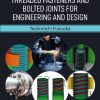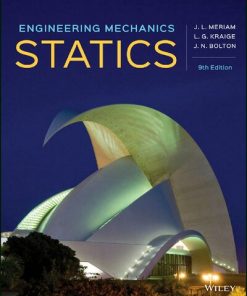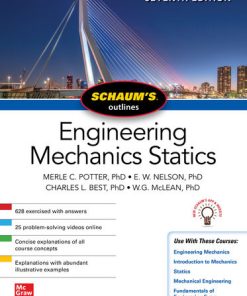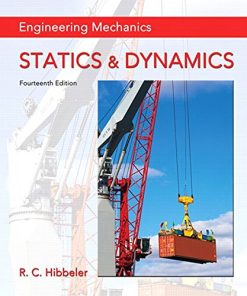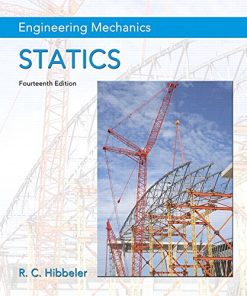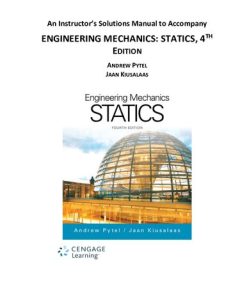Engineering Mechanics Statics 4th Edition by Andrew Pytel 8214342610 9798214342610
$50.00 Original price was: $50.00.$25.00Current price is: $25.00.
Engineering Mechanics, Statics 4th Edition by Andrew Pytel – Ebook PDF Instant Download/DeliveryISBN: 8214342610, 9798214342610
Full download Engineering Mechanics, Statics 4th Edition after payment.
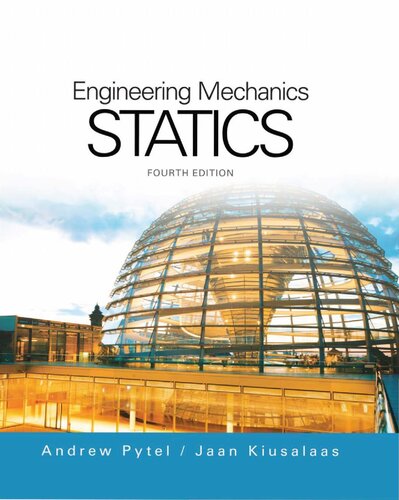
Product details:
ISBN-10 : 8214342610
ISBN-13 : 9798214342610
Author : Andrew Pytel
Provide your mechanical engineering students with a solid understanding of statics without the overload of extraneous detail in Andrew Pytel and Jaan Kiusalaas’ ENGINEERING MECHANICS: STATICS, 4E. The authors use their extensive teaching experience and first-hand knowledge to deliver a presentation that’s ideally suited to the learning skills of today’s students. The authors clearly introduce critical concepts using learning features that connect real problems and examples with the fundamentals of engineering mechanics. Students learn how to analyze problems successfully before substituting numbers into formulas. This approach benefits students tremendously as they encounter actual engineering situations that do not adhere to standard formulas. This book’s rich, concise presentation is complemented by a useful Student Study Guide that clarifies concepts with additional examples and problems as well as a wealth of instructor resources to save you time.
Engineering Mechanics, Statics 4th Table of contents:
1. Introduction to Statics
1.1. Introduction
1.1a. What Is Engineering Mechanics?
1.1b. Problem Formulation and the Accuracy of Solutions
1.2. Newtonian Mechanics
1.2a. Scope of Newtonian Mechanics
1.2b. Newton’s Laws for Particle Motion
1.2c. Inertial Reference Frames
1.2d. Units and Dimensions
1.2e. Mass, Force, and Weight
1.2f. Conversion of Units
1.2g. Law of Gravitation
1.3. Fundamental Properties of Vectors
Vectors as Directed Line Segments
1.4. Representation of Vectors Using Rectangular Components
1.4a. Rectangular Components and Direction Cosines
1.4b. Vector Addition Using Rectangular Components
1.4c. Relative Position Vectors
1.4d. How to Write a Vector in Rectangular Form
1.5. Vector Multiplication
1.5a. Dot (Scalar) Product
1.5b. Cross (Vector) Product
1.5c. Scalar Triple Product
Review of Equations
2. Basic Operations with Force Systems
2.1. Introduction
2.2. Equivalence of Vectors
2.3. Force
2.4. Reduction of Concurrent Force Systems
2.5. Moment of a Force about a Point
2.5a. Definition
2.5b. Geometric Interpretation
2.5c. Principle of Moments
2.5d. Vector and Scalar Methods
2.6. Moment of a Force about an Axis
2.6a. Definition
2.6b. Geometric Interpretation
2.6c. Vector and Scalar Methods
2.7. Couples
2.7a. Definition
2.7b. Moment of a Couple about a Point
2.7c. Equivalent Couples
2.7d. Notation and Terminology
2.7e. The Addition and Resolution of Couples
2.8. Changing the Line of Action of a Force
Review of Equations
Review Problems
3. Resultants of Force Systems
3.1. Introduction
3.2. Reduction of a Force System to a Force and a Couple
3.3. Definition of Resultant
3.4. Resultants of Coplanar Force Systems
3.4a. General Coplanar Force System
3.4b. Concurrent, Coplanar Force System
3.4c. Parallel, Coplanar Force System
3.5. Resultants of Three-Dimensional Systems
3.5a. Concurrent, Three-Dimensional Force System
3.5b. Parallel, Three-Dimensional Force System
3.5c. General Three-Dimensional Force System: The Wrench
3.6. Introduction to Distributed Normal Loads
3.6a. Surface Loads
3.6b. Line Loads
3.6c. Computation of Resultants
Review of Equations
Review Problems
4. Coplanar Equilibrium Analysis
4.1. Introduction
4.2. Definition of Equilibrium
4.3. Part A: Analysis of Single Bodies
4.4. Coplanar Equilibrium Equations
4.4a. General Case
4.4b. Concurrent Force System
4.4c. Parallel Force System
4.5. Writing and Solving Equilibrium Equations
4.6. Equilibrium Analysis for Single-Body Problems
4.7. Part B: Analysis of Composite Bodies
4.7a. Internal Forces in Members
4.7b. Internal Forces at Connections
4.8. Equilibrium Analysis of Composite Bodies
4.9. Special Cases: Two-Force and Three-Force Bodies
4.9a. Two-Force Bodies
4.9b. Three-Force Bodies
4.10. Part C: Analysis of Plane Trusses
4.11. Method of Joints
4.11a. Support Reactions
4.11b. Equilibrium Analysis of Joints
4.11c. Equilibrium Analysis of Pins
4.11d. Zero-Force Members
4.12. Method of Sections
Review of Concepts
Review Problems
5. Three-Dimensional Equilibrium
5.1. Introduction
5.2. Definition of Equilibrium
5.3. Free-Body Diagrams
5.4. Independent Equilibrium Equations
5.4a. General Case
5.4b. Concurrent Force System
5.4c. Parallel Force System
5.4d. All Forces Intersect an Axis
5.5. Improper Constraints
5.6. Writing and Solving Equilibrium Equations
5.7. Equilibrium Analysis
Review of Equations
Review Problems
6. Beams and Cables
*6.1. Introduction
*6.2. Part A: Beams
*6.3. Analysis of Internal Forces
6.3a. Loading and Supports
6.3b. Sign Convention
6.3c. Shear Force and Bending Moment Equations and Diagrams
*6.4. Area Method for Drawing V- and M-Diagrams
6.4a. Distributed Loading
6.4b. Concentrated Forces and Couples
6.4c. Summary
*6.5. Part B: Cables
6.5a. General Discussion
6.5b. Parabolic Cable
6.5c. Catenary Cable
6.5d. Note on the Solution of Problems
*6.6. Cables under Concentrated Loads
6.6a. General Discussion
6.6b. Horizontal Spacings of the Loads Are given
6.6c. Lengths of the Segments Are given
Review of Equations
7. Dry Friction
7.1. Introduction
7.2. Coulomb’s Theory of Dry Friction
7.2a. Static Case
7.2b. Impending Sliding
7.2c. Dynamic Case
7.2d. Further Discussion of Coulomb Friction
7.2e. Limitations
7.3. Problem Classification and Analysis
Type I
7.4. Impending Tipping
7.5. Angle of Friction; Wedges and Screws
7.5a. Angle of Friction
7.5b. Wedges
7.5c. Square-Threaded Screws
*7.6. Ropes and Flat Belts
*7.7. Disk Friction
New Surfaces
*7.8. Rolling Resistance
Review of Equations
Review Problems
8. Centroids and Distributed Loads
8.1. Introduction
8.2. Centroids of Plane Areas and Curves
8.2a. Definitions
8.2b. Integration Techniques
8.2c. Composite Shapes
8.3. Centroids of Curved Surfaces, Volumes, and Space Curves
8.4. Theorems of Pappus-Guldinus
Theorem I
8.5. Center of Gravity and Center of Mass
8.5a. Center of Gravity
8.5b. Center of Mass
8.5c. Composite Bodies
8.6. Distributed Normal Loads
8.6a. General Case
8.6b. Normal Loads on Flat Surfaces
8.6c. Line Loads
8.6d. Uniform Pressure on Curved Surfaces
8.6e. Fluid Pressure
Review of Equations
Review Problems
9. Moments and Products of Inertia of Areas
9.1. Introduction
9.2. Moments of Inertia of Areas and Polar Moments of Inertia
9.2a. Moment of Inertia of Area
9.2b. Polar Moment of Inertia
9.2c. Parallel-Axis Theorems
9.2d. Radius of Gyration
9.2e. Integration Techniques
9.2f. Method of Composite Areas
9.3. Products of Inertia of Areas
9.3a. Definition
9.3b. Parallel-Axis Theorem
9.4. Transformation Equations and Principal Moments of Inertia of Areas
9.4a. Transformation Equations for Moments and Products of Inertia
9.4b. Principal Moments of Inertia
*9.5. Mohr’s Circle for Moments and Products of Inertia
9.5a. Construction of Mohr’s Circle
9.5b. Properties of Mohr’s circle
9.5c. Verification of Mohr’s circle
Review of Equations
Review Problems
10. Virtual Work and Potential Energy
*10.1. Introduction
*10.2. Virtual Displacements
10.2a. Definition and Notation
10.2b. Virtual Motion of a Rigid Body
*10.3. Virtual Work
10.3a. Virtual Work of a Force
10.3b. Virtual Work of a Couple
10.3c. Virtual Work Performed on a Rigid Body
10.3d. Virtual Work for a System of Rigid Bodies
*10.4. Method of Virtual Work
10.4a. Principle of Virtual Work
10.4b. Kinematic Constraints and Independent Coordinates
10.4c. Implementation of the Method of Virtual Work
*10.5. Instant Center of Rotation
*10.6. Equilibrium and Stability of Conservative Systems
10.6a. Potential Energy
10.6b. Gravitational Potential Energy
10.6c. Elastic Potential Energy
10.6d. Stationary Potential Energy and Stability
People also search for Engineering Mechanics, Statics 4th:
varignon’s theorem in engineering mechanics
rc hibbeler engineering mechanics
journal of engineering mechanics
beer and johnston engineering mechanics
ss bhavikatti engineering mechanics pdf
Tags: Engineering Mechanics, Andrew Pytel, solid understanding, statics, the overload, extraneous
You may also like…
Engineering - Mechanical Engineering & Dynamics
Schaum’s Outline of Engineering Mechanics: Statics, 7th Edition Potter
Engineering - Engineering - General & Miscellaneous
Wiley Abridged Print Companion for Engineering Mechanics: Statics 9th Edition
Engineering - Mechanical Engineering & Dynamics
Engineering - Mechanical Engineering & Dynamics
Physics - Mechanics
Engineering Mechanics: Statics and Dynamics 3rd Edition Michael Plesha
Uncategorized
Engineering - Mechanical Engineering & Dynamics
Engineering Mechanics: statics, Instructor’s Solutions Manual 4th Edition Andrew Pytel



